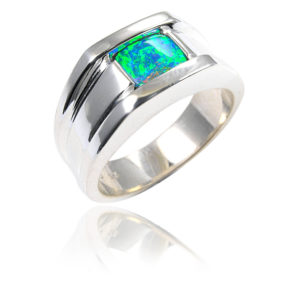Every day we have people come into the store, ring us up, or email us with questions on the limitations of setting opal, and what can and can’t be done.
Obviously, opal isn’t as hard as diamonds (where diamonds sit at the highest level of 10 on the Mohs gemstone hardness scale, opals rate at about 6.5), so some settings, such as tension settings (where you see the gemstone ‘floating’ in the setting) are just not suitable for opal due to its softer nature.
We’ve also been asked about faceting our opals before, which we would recommend against. If we were to facet an opal, the points would wear or chip quite easily, not to mention that faceting would interfere with opal’s natural play of colour.
However, despite some of these limitations, there are still countless ways to set opal, maximising its amazing display of colour and patterns.
Here’s some tips that can help though –
- – Blue, green and purple hues really come to life in whiter metals (silver, white gold, platinum), as the cooler tones complement each other
- – Same goes for Red, orange and pink hues in Yellow or Rose gold settings. That said, some deeper, more vivid greens look absolutely amazing in the warmer metals.
- – If you’re adamant on having a cocktail/solitaire-style ring setting, try and have thicker claws, more than 4 claws, or even a halo of complementing stones around the opal to help protect it.
- – Boulder Opal generally has a freeform and undulating appearance; take full advantage of this with more modern contemporary designs that flow with the stone.
- – Experiment with looks and tones for the complementing stones. While we generally use white diamonds with most of our opals, gemstones like pink sapphires can suit light blue opals, black diamonds can look magnificent alongside bright green or red/orange opals, etc.
- – If you’re determined to have a cluster of opals, just remember, the smaller the stones, the less variation in pattern, colours you will get. Opals are all about their amazing colours and breathtaking patterns, so they do need some surface area to display this. You won’t get something outstanding with a 3mm round opal.


